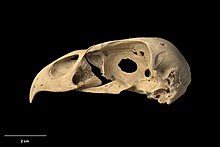Eyles's harrier
| Eyles's harrier Temporal range: Pleistocene-Holocene
| |
|---|---|

| |
| Eyles's harrier skull held at Te Papa, Wellington | |
| Scientific classification | |
| Domain: | Eukaryota |
| Kingdom: | Animalia |
| Phylum: | Chordata |
| Class: | Aves |
| Order: | Accipitriformes |
| Family: | Accipitridae |
| Genus: | Circus |
| Species: | †C. teauteensis
|
| Binomial name | |
| †Circus teauteensis Forbes, 1892
| |
| Synonyms | |
|
Circus hamiltoni (nomen nudum) | |
Eyles's harrier (Circus teauteensis) (
Name
This species was named after Jim Eyles, paleontologist and former director of the Nelson Provincial Museum and the West Coast Museum.
Description
It was an example of island gigantism, as an adult female weighed around 2.5 to 3 kg (5.5 to 6.6 lb), over twice as much as a swamp harrier.[5][6] Its shape differed from that of most other harriers, and it was initially mistaken for a huge hawk, possibly a giant Accipiter.
Ecology
It was a generalist predator, taking prey of the same size as small eagle species do: land animals weighing one or a few kilograms. In its hunting strategy, however, it was more adapted to avian prey, as aside from bats, mammals were entirely absent from New Zealand. Presumably, it hunted diurnal birds in a manner similar to goshawks.
Taxonomy
Eyles' harrier was presumably somewhat similar to the living spotted harrier, its closest living relative, from which it diverged around 2.4 million years ago.[7]
The
Extinction
The modern
References
- ^ "Circus teauteensis. NZTCS". nztcs.org.nz. Retrieved 3 April 2023.
- ^ "Eyles' harrier | Kērangi | New Zealand Birds Online". nzbirdsonline.org.nz. Retrieved 2023-11-26.
- ^ "Eyles' harrier | New Zealand Birds Online". www.nzbirdsonline.org.nz. Retrieved 2022-05-21.
- ^ ISBN 978-0-909010-21-8.
- ^ Holdaway, R. N. (1989). New Zealand’s pre-human avifauna and its vulnerability. New Zealand journal of ecology, 12(supplement), 11-25.
- . Retrieved 1 October 2022.
- S2CID 73420145.
- ^ ISBN 0-253-34034-9


